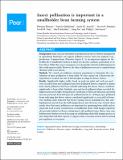| dc.description.abstract | Many crops are dependent on pollination by insects. Habitat management in agricultural landscapes can support pollinator services and even augment crop production. Common bean ( L.) is an important legume for the livelihoods of smallholder farmers in many low-income countries, particularly so in East Africa. While this crop is autogamous, it is frequently visited by pollinating insects that could improve yields. However, the value of pollination services to common beans (Kariasii) yield is not known.
We carried out pollinator-exclusion experiments to determine the contribution of insect pollinators to bean yields. We also carried out a fluorescent-dye experiment to evaluate the role of field margins as refuge for flower-visitors.
Significantly higher yields, based on pods per plant and seeds per pod, were recorded from -pollinated and -pollinated flowers compared to plants from which pollinators had been excluded indicating that flower visitors contribute significantly to bean yields. Similarly, and -pollinated plants recorded the highest mean seed weight. Extrapolation of yield data to field scale indicated a potential increase per hectare from 681 kg in -pollinated beans to 1,478 kg in -pollinated beans indicating that flower visitors contributed significantly to crop yield of beans. Our marking study indicated that flower-visiting insects including bees, flies and lepidopterans moved from the field margin flowers into the bean crop. Overall, these results show that insect pollinators are important for optimising bean yields and an important food security consideration on smallholder farms. Field margin vegetation also provides habitat for flower-visiting insects that pollinate beans. Hence, non-crop habitats merit further research focusing on establishing which field margin species are most important and their capacity to support other ecosystem services such as natural pest regulation or even pests. | en_US |

